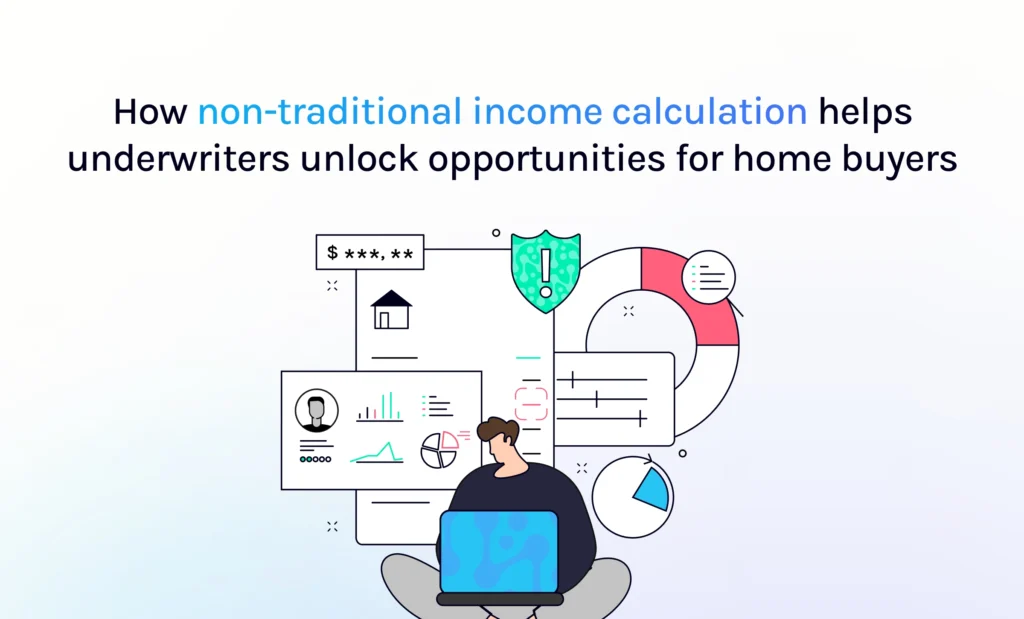This website uses cookies so that we can provide you with the best user experience possible. Cookie information is stored in your browser and performs functions such as recognising you when you return to our website and helping our team to understand which sections of the website you find most interesting and useful.
How non-traditional income calculation helps underwriters unlock opportunities for home buyers

Over the last few years, the average borrower seeking home loans has significantly changed. The demand for gig work increased by 41% between 2016 and 2023, leading to various non-traditional income sources.
Today, an increasing number of applicants are non-standard wage earners or have multiple income sources ranging from rental income to alimony. This shift presents a unique challenge and opportunity for mortgage lenders.
Using traditional income calculation methods that may not capture these borrowers’ complete financial picture can lead to lenders overlooking viable applicants and home buyers losing out on opportunities to secure their dream homes.
By leveraging document automation technology, mortgage lenders can gain a more comprehensive understanding of non-traditional borrowers – and unlock new opportunities for home buyers.
Challenges with manual income calculations
Difficulties in manually calculating income from diverse sources like gig work can lead lenders to shy away from potential opportunities. This cautious stance often translates into real consequences for borrowers, who might find themselves either unable to secure a mortgage or forced to accept loans at higher interest rates.
For many, the tedious process of manually verifying inconsistent non-wage incomes like rental, investment property and side gig income is too tedious and risky to pursue. This becomes even more complex when considering additional sources of income, such as social security, child support, or alimony.
As a result, underwriters often struggle to accurately calculate income, leading to delays in the approval process – or even denials.
How traditional methods of income calculations fall short
Calculating the income of non-traditional borrowers is more complex than evaluating W-2 forms, and traditional methods can often fall short. For example, traditional income calculation methods may need to adequately account for the variability and seasonality of non-traditional income sources.
Beyond not fully capturing borrowers’ diverse income, traditional “stare and compare” income calculation methods significantly increase the likelihood of mistakes and limit lenders’ view of borrowers.
The manual process of collecting and analyzing multiple documents, such as tax returns and bank statements, can be time-consuming and prone to errors. With a more sophisticated approach to income verification, lenders may appreciate a borrower’s ability to repay their mortgage or may impose overly stringent lending requirements.

Increase approvals with intelligent document automation.
Intelligent document automation enables lenders to better serve non-traditional borrowers by standardizing and performing income calculations across a broad spectrum of data and income profiles.
Ocrolus supports various income sources, such as rental income and self-employment, and is constantly working to expand its coverage to include social security, retirement, alimony, child support and disability payments. With expanded coverage, this technology allows lenders to go beyond pre-defined analytics to help them more accurately and efficiently determine a borrower’s creditworthiness.
By standardizing and performing complex income calculations across a broad spectrum of data and income profiles, underwriters can reduce errors and delays while ensuring a comprehensive analysis of each applicant. As a result, mortgage lenders can more confidently extend offers to a broader audience with more diverse income streams, promoting more inclusive and equitable lending decisions.
Ultimately, there is no cookie-cutter family or borrower, and mortgage lending decisions must be based on each applicant’s unique situation.
By adopting intelligent document automation and moving away from rigid, traditional standards, lenders can consider various income sources beyond traditional W-2 forms. As a result, underwriters can gain a more comprehensive understanding of each applicant while making homeownership more accessible to a diverse range of borrowers.
Book a demo to learn how Ocrolus’ automated income calculation and verification helps lenders speed up the underwriting process for a better borrower experience.
Key takeaways
- The rise of non-traditional income sources like gig work and rental income presents a challenge for mortgage lenders using traditional income calculation methods, potentially overlooking viable borrowers.
- Manual income calculations are tedious and prone to error, and they often need to accurately assess borrowers’ financial profiles with non-traditional income, leading to loan denials or higher interest rates.
- Adopting intelligent document automation technology enables lenders to more accurately and efficiently evaluate non-traditional income and applicants with multiple income sources. This leads to more inclusive lending practices and opportunities for home buyers.





